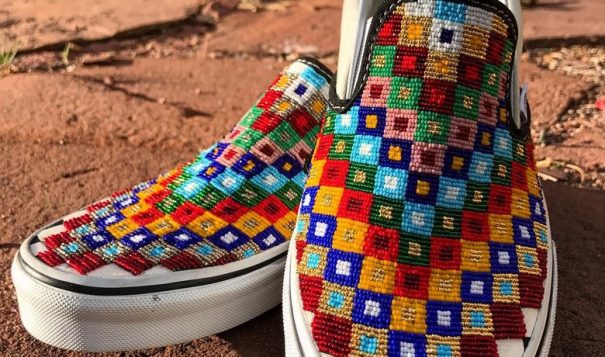 Photos: Courtesy of Charlene Holy Bear
Photos: Courtesy of Charlene Holy Bear
The Native American artist Charlene Holy Bear’s first foray into fashion came four years ago, when she made a last-minute decision to attend the annual Gathering of Nations in Albuquerque, a pan-tribal festival also known as “North America’s largest powwow.”
“Everyone gets all dressed up in their traditional regalia,” says Holy Bear, a member of the Standing Rock Lakota Sioux Tribe who is known for her intricate beadwork. “I hadn’t had any time to prepare outfits for us but I wanted my 4-year-old son Justus to look really cool. He had a new pair of slip-on Vans and I suddenly had an idea, looking at the checkerboard design.” Over the course of the three-day road trip to the festival, Holy Bear started hand-beading the kicks and the finished product—a classic skate shoe tricked out with vibrantly intricate traditional Lakota beadwork—now has a waiting list full of street style–obsessed collectors clamoring for a customized pair.
“Those Vans really reminded me of traditional moccasins,” says Holy Bear. “Once they were beaded they had this sort of urban Indian vibe so I braided my son’s hair, put on those shoes and he was the coolest little guy at the powwow. People were stopping us to take photos, he made such a splash.” Not long afterward one of those photos made its way onto Pinterest and caught the eye of Amanda Miller, the communications director at PayPal. “She contacted me to see if I would make her a pair and it just kind of grew from there,” says Holy Bear, who showed up on Vans’s radar recently too and was sent a pallet of the classic slip-ons to work with.

Born into a family of artists, Holy Bear first began hand-beading traditional Plains dolls when she was just five years old, learning from her sister Rhonda Holy Bear, an accomplished artist in her own right. A few years later, she entered a doll into a youth competition at the Santa Fe Indian Market and won her first award, a second-place ribbon. She used the prize money to buy her own horse. As a teen, she was picked up by the Morning Star Gallery in Santa Fe and used the sales of her dolls to put herself through the University of New Mexico, where she studied fine arts and art history. After graduating, Holy Bear spent years on the Native American arts fair circuit, traveling from California to Arizona, New Mexico, Oklahoma, and Indiana just to sell her wares. “Social media all changed that,” she says. “I started posting photos on Instagram and people started to contact me looking to buy or have pieces made instead.”
Inspired by powwow regalia, Holy Bear has spent the last few years working on neo-traditional pendants and earrings depicting florals and animals like hummingbirds and swallows made from antique Venetian seed beads. “I love working on the shoes though because it gives me such creative freedom,” she says. “I’m really into florals right now and I’ve been working on some new designs for the Vans.” Holy Bear is still a one-woman show, laying out every pattern and hand-stitching each bead using traditional methods. Each custom pair of Vans can take up to two weeks to produce; prices vary depending on the type of beads used (14-karat gold are a popular choice). “To me these Vans really represent a modern spin on native fashion,” she says.

Photos: Courtesy of Charlene Holy Bear
“I went home to the reservation recently wearing a pair and my sister called me a ‘city Indian,’ so I guess that’s what they say to other people, too.”
Moving forward into 2018, Holy Bear is hoping to expand into apparel (hand-beaded leather jackets were mentioned) but for now she’s still cruising on the success the Vans have brought her. “This all started because of my son,” she says. “So I just made him a new pair for Christmas.”
